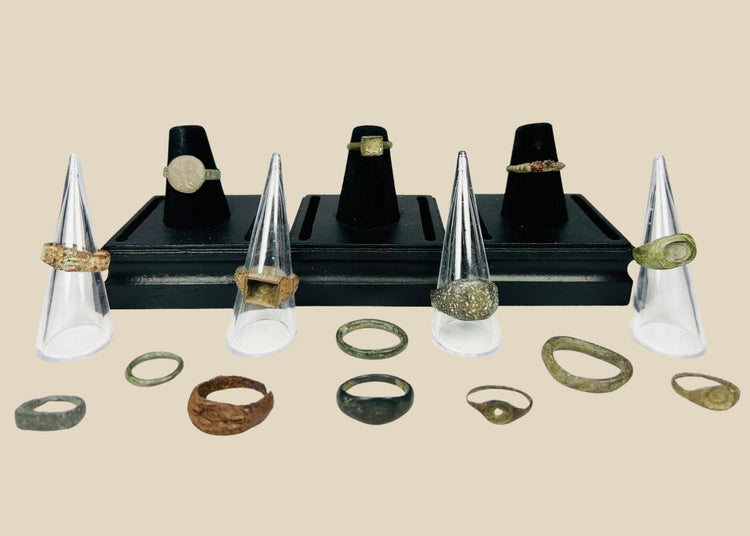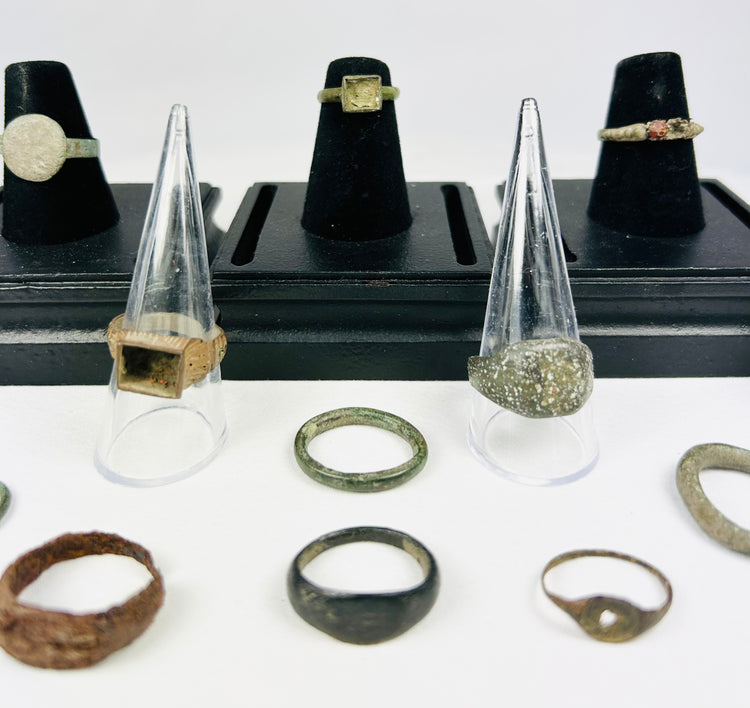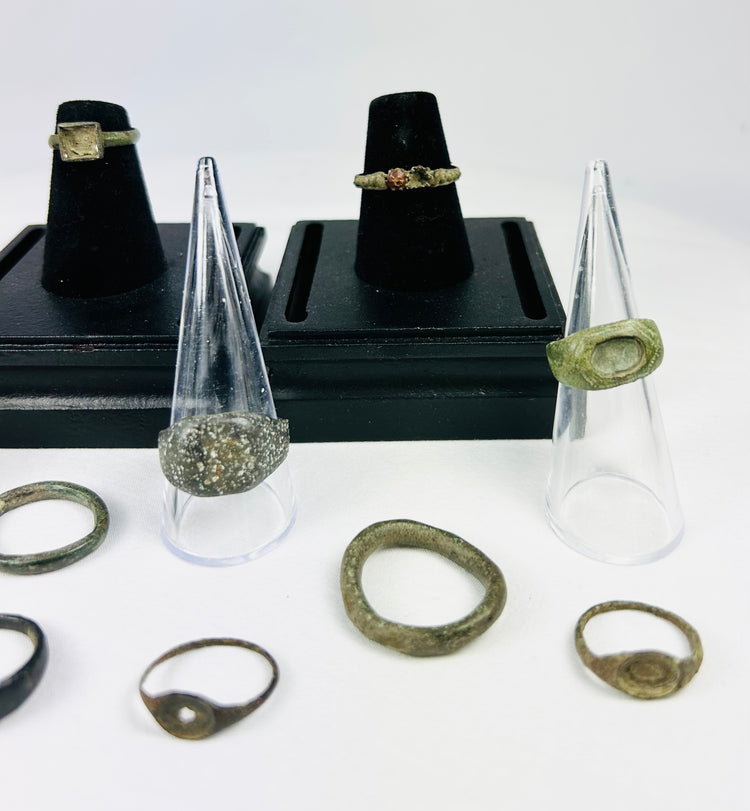Collection of 15 Ancient & Medieval Rings | Egypt to Europe | 1000 BCE – 15th Century CE
Description
More
Less
Historical Context & Origin
Region: Egypt, Rome, Byzantium, Scandinavia, Western Europe
Material: Primarily bronze, with varied patinas and designs
Period: Circa 1000 BCE – 15th Century CE
Description
This exceptional collection of fifteen ancient rings represents a sweeping journey through world history, spanning over two millennia. From the elegance of Ancient Egypt to the martial artistry of the Viking era, and from Roman administrative rings to medieval wedding bands, each piece demonstrates the artistry, symbolism, and craftsmanship of its respective culture. The rings showcase diverse functions, including personal adornment, ceremonial symbolism, and practical use in sealing documents.
Features
- Roman Bronze Signet Ring (1st–4th Century CE): Circular bezel design, once used for sealing official documents.
- Medieval Bronze Wedding Ring (12th–15th Century CE): Smooth and simple band symbolizing marriage vows.
- Viking-Era Bronze Ring (8th–11th Century CE): Square bezel with intricate Norse design, embodying ceremonial artistry.
- Ancient Egyptian Ring (ca. 1000 BCE): Flat bezel with rich patina, reflecting Egypt’s enduring love of jewelry.
- Byzantine Bronze Finger Ring (6th–9th Century CE): Elegant with finely engraved detail, representing status and sophistication.
- Late Roman Bronze Ring (3rd–5th Century CE): Likely once inlaid with a gem or glass, signifying higher social rank.
- Additional Pieces (not individually listed): The remaining rings offer a variety of styles and functions, completing the 15-piece ensemble that spans from antiquity into the medieval world.
Cultural Significance
Rings served as powerful symbols across civilizations—denoting status, identity, devotion, and authority. Egyptian rings reflected spiritual and daily adornment; Roman rings embodied administrative power; Byzantine pieces showcased artistic refinement; Viking rings conveyed both cultural pride and ceremonial use; and medieval wedding bands symbolized enduring vows. Together, these artifacts provide a panoramic view of jewelry’s role across cultures and centuries.
Condition
Each ring shows age-appropriate wear and patina, with some retaining traces of their original finishes. Despite their antiquity, the collection remains remarkably intact, preserving the artistry and authenticity of multiple civilizations.
Dimensions (approximate)
Varied sizes across the collection, each suitable for display.
Age
Circa 1000 BCE – 15th Century CE
Learn More
Learn about the medieval era and historical context of rings and jewelry: The Medieval Era – MedievalTimes Education
Browse similar rings and antique jewelry from our curated collection: Rings & Ancient Jewelry – Relic And Rarity
Description
Historical Context & Origin
Region: Egypt, Rome, Byzantium, Scandinavia, Western Europe
Material: Primarily bronze, with varied patinas and designs
Period: Circa 1000 BCE – 15th Century CE
Description
This exceptional collection of fifteen ancient rings represents a sweeping journey through world history, spanning over two millennia. From the elegance of Ancient Egypt to the martial artistry of the Viking era, and from Roman administrative rings to medieval wedding bands, each piece demonstrates the artistry, symbolism, and craftsmanship of its respective culture. The rings showcase diverse functions, including personal adornment, ceremonial symbolism, and practical use in sealing documents.
Features
- Roman Bronze Signet Ring (1st–4th Century CE): Circular bezel design, once used for sealing official documents.
- Medieval Bronze Wedding Ring (12th–15th Century CE): Smooth and simple band symbolizing marriage vows.
- Viking-Era Bronze Ring (8th–11th Century CE): Square bezel with intricate Norse design, embodying ceremonial artistry.
- Ancient Egyptian Ring (ca. 1000 BCE): Flat bezel with rich patina, reflecting Egypt’s enduring love of jewelry.
- Byzantine Bronze Finger Ring (6th–9th Century CE): Elegant with finely engraved detail, representing status and sophistication.
- Late Roman Bronze Ring (3rd–5th Century CE): Likely once inlaid with a gem or glass, signifying higher social rank.
- Additional Pieces (not individually listed): The remaining rings offer a variety of styles and functions, completing the 15-piece ensemble that spans from antiquity into the medieval world.
Cultural Significance
Rings served as powerful symbols across civilizations—denoting status, identity, devotion, and authority. Egyptian rings reflected spiritual and daily adornment; Roman rings embodied administrative power; Byzantine pieces showcased artistic refinement; Viking rings conveyed both cultural pride and ceremonial use; and medieval wedding bands symbolized enduring vows. Together, these artifacts provide a panoramic view of jewelry’s role across cultures and centuries.
Condition
Each ring shows age-appropriate wear and patina, with some retaining traces of their original finishes. Despite their antiquity, the collection remains remarkably intact, preserving the artistry and authenticity of multiple civilizations.
Dimensions (approximate)
Varied sizes across the collection, each suitable for display.
Age
Circa 1000 BCE – 15th Century CE
Learn More
Learn about the medieval era and historical context of rings and jewelry: The Medieval Era – MedievalTimes Education
Browse similar rings and antique jewelry from our curated collection: Rings & Ancient Jewelry – Relic And Rarity
You May Also Like























